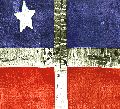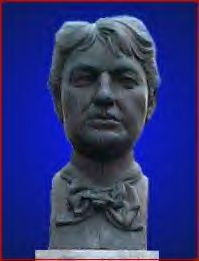|
Mariana Bracetti
Mariana Bracetti Cuevas (also spelled Bracety) (1825–1903) was a patriot and leader of the Puerto Rico independence movement in the 1860s. She is attributed with having knitted the flag that was intended to be used as the national emblem of Puerto Rico in its attempt to overthrow the Spanish government on the island, and to establish the island as a sovereign republic. The attempted overthrow was the Grito de Lares, and Bracetti's creation became known as "The Flag of Lares." The flag's design was later adopted as the official flag of the municipality of Lares, Puerto Rico. Early years Bracetti, born in the city of Añasco, Puerto Rico, met and developed a romantic relationship with Miguel Rojas Luzardo, a rich Venezuelan businessman visiting Añasco. Rojas and his brother Manuel owned a coffee plantation called "El Triunfo" near Lares. Miguel and Manuel Rojas were admirers of Dr. Ramón Emeterio Betances and were influenced by his ideals of independence for and beyond Puerto ... [...More Info...] [...Related Items...] OR: [Wikipedia] [Google] [Baidu] |
Añasco, Puerto Rico
Añasco (, ), named after one of its settlers, Don Luis de Añasco, is a town and municipality of Puerto Rico located on the west coast of the island bordering the Mona Passage to the west, north of Mayagüez, and Las Marias; south of Rincón, Aguada, and Moca and west of San Sebastián and Las Marias. It is part of the Aguadilla-Isabela-San Sebastián Metropolitan Statistical Area. Etymology and nicknames The name ''Añasco'' comes from Don Luis de Añasco, former owner of the land where the town and municipality were founded. This family name is of Spanish origin from the province of Extremadura. Some of the municipality's nicknames include: ''La ciudad donde los dioses mueren'' ("The city where gods die") and ''Los nativos'' ("the natives") are a reference to the legend of Spanish conquistador Diego Salcedo who according to the story was drowned by the indigenous Taíno in order to prove that the European colonizers were not immortal deities; and ''Pueblo del Hoja ... [...More Info...] [...Related Items...] OR: [Wikipedia] [Google] [Baidu] |
Mayagüez, Puerto Rico
Mayagüez (, ) is a city and the eighth-largest municipality in Puerto Rico. It was founded as Nuestra Señora de la Candelaria de Mayagüez, and is also known as ''La Sultana del Oeste'' (The Sultaness of the West), ''Ciudad de las Aguas Puras'' (City of Pure Waters), or ''Ciudad del Mangó'' (Mango City). On April 6, 1894, the Spanish Crown granted it the formal title of ''Excelente Ciudad de Mayagüez'' (''Excellent City'' of Mayagüez). Mayagüez is located in the center of the western coast on the island of Puerto Rico. It has a population of 73,077 in the city proper, and it is a principal city of the Mayagüez Metropolitan Statistical Area (pop. 88,731) and the Mayagüez–San Germán–Cabo Rojo Combined Statistical Area (pop. 213,831). History The Mayagüez Metro Area (and part of Añasco) lies today on two former Taíno Cacicazgos (chiefdoms): Yaguex and Yagüeca, a region noted for its record of colonial resistance (i.e., Urayoán and Legend of Diego Salcedo). ... [...More Info...] [...Related Items...] OR: [Wikipedia] [Google] [Baidu] |
Lola Rodríguez De Tió
Lola Rodríguez de Tió,This name uses Spanish marriage naming customs; the first is the maiden family name ''"Rodríguez"'' and the second or matrimonial family name is ''"Tió"''. (September 14, 1843 – November 10, 1924), was the first Puerto Rican-born woman poet to establish herself a reputation as a great poet throughout all of Latin America. A believer in women's rights, she was also committed to the abolition of slavery and the independence of Puerto Rico. Early years Rodríguez de Tió was born Dolores Rodríguez de Astudillo y Ponce de León in San Germán, Puerto Rico. Her father, Sebastián Rodríguez de Astudillo, was one of the founding members of the Ilustre Colegio de Abogados de Puerto Rico (literally, "Illustrious College of Attorneys," the governing body for Spanish attorneys in Puerto Rico, similar to a bar association). Lola's mother, Carmen Ponce de León, was a descendant of Juan Ponce de León, who was an explorer, and the first Spanish Governor of P ... [...More Info...] [...Related Items...] OR: [Wikipedia] [Google] [Baidu] |
María De Las Mercedes Barbudo
María de las Mercedes Barbudo (1773 – February 17, 1849) was a Puerto Rican political activist, the first woman ''Independentista'' in the island, and a "Freedom Fighter".Natalia de Cuba, "Puerto Rico's first female Freedom Fighter" (PDF), ''San Juan Star'', October 20, 1997; page 30, Retrieved on June 20, 2011. , ''Dictionary Reverso'', Retrieved on June 20, 2011. At the time, the Puerto Rican independence move ...
[...More Info...] [...Related Items...] OR: [Wikipedia] [Google] [Baidu] |
Brazo De Oro (wrestler)
Jesús Alvarado Nieves ( October 7, 1959 – April 28, 2017) was a Mexican ''luchador'', or professional wrestler, who worked under the ring name Brazo de Oro ( Spanish for "Golden Arm"). He was a part of the Alvarado wrestling family, the son of Shadito Cruz and brother of Brazo de Plata, El Brazo, Brazo Cibernético, Super Brazo and Brazo de Platino. His son Felipe de Jesús Alvarado Mendoza currently works as La Máscara for Consejo Mundial de Lucha Libre. His nephews, Máximo Sexy and Psycho Clown are featured wrestlers for CMLL and Lucha Libre AAA Worldwide respectively. Alvarado made his debut in 1975 and for over a decade wrestled under a wrestling mask, until he and his brothers Brazo de Plata and El Brazo lost a ''Lucha de Apuestas'' match to ''Los Villanos'' in 1988 and was forced to unmask. Over the years he has teamed with his brothers to win various championships such as the CMLL World Trios Championship, Mexican National Tag Team Championship, Mexican National Trio ... [...More Info...] [...Related Items...] OR: [Wikipedia] [Google] [Baidu] |
History Of Women In Puerto Rico
The recorded history of Puerto Rican women can trace its roots back to the era of the ''Taíno'', the indigenous people of the Caribbean, who inhabited the island that they called "Boriken" before the arrival of Spaniards. During the Spanish colonization the cultures and customs of the Taíno, Spanish, African and women from non-Hispanic European countries blended into what became the culture and customs of Puerto Rico. In the early part of the 19th Century the women in Puerto Rico were Spanish subjects and had few individual rights. Those who belonged to the upper class of the Spanish ruling society had better educational opportunities than those who did not. However, there were many women who were already active participants in the labor movement and in the agricultural economy of the island."Introduction, ... [...More Info...] [...Related Items...] OR: [Wikipedia] [Google] [Baidu] |
Corsican Immigration To Puerto Rico
Corsican immigration to Puerto Rico resulted in the 19th century from widespread economic and political changes in Europe that made life difficult for the peasant and agricultural classes in Corsica and other territories. The Second Industrial Revolution drew more people into urban areas for work, widespread crop failure resulted from long periods of drought, and crop diseases, and political discontent rose. In the early nineteenth century, Spain lost most of its possessions in the so-called "New World" as its colonies won independence. It feared rebellion in its last two Caribbean colonies: Puerto Rico and Cuba. The Spanish Crown had issued the Royal Decree of Graces of 1815 (''Real Cédula de Gracias'') which fostered and encouraged the immigration of European Catholics, even if not of Spanish origin, to its Caribbean colonies. Hundreds of families emigrated from Corsica to Puerto Rico. Corsicans and those of Corsican descent played an instrumental role in the development of th ... [...More Info...] [...Related Items...] OR: [Wikipedia] [Google] [Baidu] |
Philadelphia
Philadelphia, often called Philly, is the largest city in the Commonwealth of Pennsylvania, the sixth-largest city in the U.S., the second-largest city in both the Northeast megalopolis and Mid-Atlantic regions after New York City. Since 1854, the city has been coextensive with Philadelphia County, the most populous county in Pennsylvania and the urban core of the Delaware Valley, the nation's seventh-largest and one of world's largest metropolitan regions, with 6.245 million residents . The city's population at the 2020 census was 1,603,797, and over 56 million people live within of Philadelphia. Philadelphia was founded in 1682 by William Penn, an English Quaker. The city served as capital of the Pennsylvania Colony during the British colonial era and went on to play a historic and vital role as the central meeting place for the nation's founding fathers whose plans and actions in Philadelphia ultimately inspired the American Revolution and the nation's inde ... [...More Info...] [...Related Items...] OR: [Wikipedia] [Google] [Baidu] |
Statue Of Mariana Bracety Cuevas In Añasco Barrio-pueblo, Puerto Rico
A statue is a free-standing sculpture in which the realistic, full-length figures of persons or animals are carved or cast in a durable material such as wood, metal or stone. Typical statues are life-sized or close to life-size; a sculpture that represents persons or animals in full figure but that is small enough to lift and carry is a statuette or figurine, whilst one more than twice life-size is a colossal statue. Statues have been produced in many cultures from prehistory to the present; the oldest-known statue dating to about 30,000 years ago. Statues represent many different people and animals, real and mythical. Many statues are placed in public places as public art. The world's tallest statue, ''Statue of Unity'', is tall and is located near the Narmada dam in Gujarat, India. Color Ancient statues often show the bare surface of the material of which they are made. For example, many people associate Greek classical art with white marble sculpture, but there is evidenc ... [...More Info...] [...Related Items...] OR: [Wikipedia] [Google] [Baidu] |
Arecibo
Arecibo (; ) is a city and municipality on the northern coast of Puerto Rico, on the shores of the Atlantic Ocean, located north of Utuado and Ciales; east of Hatillo; and west of Barceloneta and Florida. It is about west of San Juan, the capital city. Arecibo is the largest municipality in Puerto Rico by area, and it is the core city of the Arecibo Metropolitan Statistical Area and part of the greater San Juan Combined Statistical Area. It is spread over 18 ''barrios'' and Arecibo Pueblo (the downtown area and the administrative center of the city). Its population in 2020 was 87,754. The Arecibo Observatory, which housed the Arecibo telescope, the world's largest radio telescope until July 2016, is located in the municipality. The Arecibo telescope collapsed on December 1, 2020. Arecibo is the seat of the Roman Catholic Diocese of Arecibo. Etymology and nicknames The name ''Arecibo'' comes from the Taíno chief Xamaica Arasibo, cacique of the ''yucayeque'' (Taíno ... [...More Info...] [...Related Items...] OR: [Wikipedia] [Google] [Baidu] |
San Sebastián, Puerto Rico
San Sebastián (, ) is a town and municipality of Puerto Rico located in the northwestern region of the island, south of Isabela, Quebradillas and Camuy; north of Las Marías; east of Moca and Añasco; and west of Lares. San Sebastián is spread over twenty-four barrios and San Sebastián Pueblo (the downtown area and the administrative center of the city). It is a principal city of the Aguadilla-Isabela-San Sebastián Metropolitan Statistical Area. History The permission to found the town was officially granted in 1752, under the leadship of the founder, Captain Cristóbal González de la Cruz, who among other residents had an interest in converting some cow farms into an agricultural village. The foundation of the town from the religious aspect, was consummated in December 1762 by Mariano Martin, the island catholic bishop at that time. At the beginning, by 1700, San Sebastián was a conglomerate of a few cow farms, owned by some residents of the Partido de Aguada. La ... [...More Info...] [...Related Items...] OR: [Wikipedia] [Google] [Baidu] |



